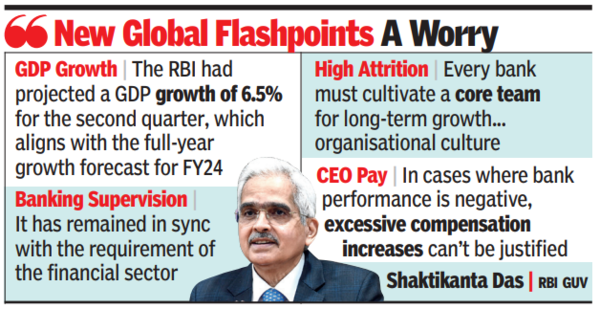MUMBAI: RBI governor Shaktikanta Das has said that GDP growth for the second quarter of FY24 is likely to surpass expectations based on early indicators. The central bank had projected a GDP growth of 6.5% for the second quarter, which aligns with the full-year growth forecast for FY24.
“Looking at the momentum of economic activity and several early data points and indicators that have emerged, I can confidently say that the second quarter GDP figures, expected to be released at the end of November, in all probability will surpriseeveryone on the upside,” said Das.The governor made these remarks during a fireside chat at a banking event organised byBusiness Standard on Tuesday.

At the same time, Das highlighted geopolitical risks and their potential impact on financial markets as the key concerns. “The most significant challenge for every country is evolving geopolitics and new flashpoints. Today, I believe this poses the biggest risk to global growth,” Das said.
Within the domestic financial system, Das also discussed RBI’s focus on the high attrition rates in private banks. In their annual reports for the previous financial years, private banks reported remarkably high attrition rates, with some indicating up to 50% attrition among their front-end staff. “We have asked banks to address this issue because, ultimately, every bank must cultivate a core team for long-term growth. There has to be something called organisational culture ,” Das said.
Das also mentioned the RBI’s examination of the business models of banks to understand the risk appetite factored into their business plans. “We are looking at the structural issues in the balance sheet to ensure that risk appetite is adequately supported by risk mitigation measures. We are evaluating the revenue models of banks, particularly if they are prioritising short-term gains over long-term risks,” he said.
Das pointed out that central banks and regulators worldwide have recognised the need for enhanced supervision, especially after bank failures in the US and Switzerland. ” I can say with confidence that our supervision has by no means fallen behind the curve. It has remained in sync with the requirement of the growing complexities of the financial sector the world over.”
“Looking at the momentum of economic activity and several early data points and indicators that have emerged, I can confidently say that the second quarter GDP figures, expected to be released at the end of November, in all probability will surpriseeveryone on the upside,” said Das.The governor made these remarks during a fireside chat at a banking event organised byBusiness Standard on Tuesday.

At the same time, Das highlighted geopolitical risks and their potential impact on financial markets as the key concerns. “The most significant challenge for every country is evolving geopolitics and new flashpoints. Today, I believe this poses the biggest risk to global growth,” Das said.
Within the domestic financial system, Das also discussed RBI’s focus on the high attrition rates in private banks. In their annual reports for the previous financial years, private banks reported remarkably high attrition rates, with some indicating up to 50% attrition among their front-end staff. “We have asked banks to address this issue because, ultimately, every bank must cultivate a core team for long-term growth. There has to be something called organisational culture ,” Das said.
Das also mentioned the RBI’s examination of the business models of banks to understand the risk appetite factored into their business plans. “We are looking at the structural issues in the balance sheet to ensure that risk appetite is adequately supported by risk mitigation measures. We are evaluating the revenue models of banks, particularly if they are prioritising short-term gains over long-term risks,” he said.
Das pointed out that central banks and regulators worldwide have recognised the need for enhanced supervision, especially after bank failures in the US and Switzerland. ” I can say with confidence that our supervision has by no means fallen behind the curve. It has remained in sync with the requirement of the growing complexities of the financial sector the world over.”
Source link

